How to Use a Wheelchair
Congratulations on your new wheelchair! I’m sure by now you’ve already heard the entire speech about always locking your brakes before transferring and to avoid the stairs, so I’m not going to worry about that. I’m here to cover all the stuff that PTs, OTs, and PCPs often leave out.
How to Sit Properly
The first step to correctly using a wheelchair is knowing how to sit in it properly. When properly seated in your wheelchair, your pelvis should be level and your spine straight. Your feet (if you have them) should sit flatly and firmly on the foot rest. If you’re slumping forward (posterior pelvic tilt), arching your back (anterior pelvic tilt), or one side of your pelvis sits higher than the other (pelvic obliquity) you may need to reevaluate the type of cushion you’re using or look into adding support via something like a body band. The same also applies if you find yourself slowly sliding out of your chair throughout the day (pelvic migration).
Even when properly positioned in your new chair, it may still feel a bit strange. A new chair is often like a new pair of shoes: it takes time for your body to get used to it. But let me be clear here: I’m not talking about pain or discomfort. There’s a big difference between “This shoe leather is new” and “I can’t feel my toes”. If you’re experiencing pain or discomfort while sitting in your wheelchair, tell your doctor.
How to Get Moving
Moving a Wheelchair isn’t that hard. Just grip the wheels and push, right? In practice, there’s a lot more to it. In order to properly push your chair, you need to use the proper grip, lean into the push, and let the chair do the work.
Use the Proper Grip
When pushing your chair, especially up an incline or over a wet surface, always grip both the rim and the tire. When you push, your thumbs should be resting parallel on top of the tires. Using the proper grip will give you more control and keep your hands from slipping while you push.
Lean Into the Push
To get the most power per push, start with your hands pulled back near your hips and lean forward as you push. The farther you lean forward, the more power your push will have. This is especially helpful when heading up inclines or over rough terrain.
Let the Chair Do the Work
Not letting the chair do the work is by far the most common mistake new wheelchair users make. Your wheelchair is designed to save you energy when moving around, but only if you let it. Often times, new wheelchair users will let their hands drag on the wheel as the reset for another push. This causes a lot of drag on the wheel and causes you to slow down while moving forward. When you push your chair, your hands should completely leave the wheels. To prevent yourself from grabbing the wheels between pushes, let your hands and arms follow the circumference of your wheels with each push. When done correctly, your arms should be moving in a circular motion along with your wheels.
When turning, you should be moving both wheels instead of keeping one stationary and trying to rotate the chair. For example, when turning left, you should pull backwards on the left tire while simultaneously pushing forward on the right tire. This will give you a faster, smoother, and more controlled turn versus keeping one tire stationary.
How to Lift the Front Of Your Chair
Lifting the front of your chair (aka “popping a wheelie”) is far more than a party trick; it’s actually one of the more important skills you should learn as a wheelchair user. To lift the front of your chair, quickly push your chair forward while leaning backwards. The amount of pressure you will need to apply to the tires and how far you will need to lean backwards depends on how the center of gravity is configured on your chair. Refer to the user manual for your wheelchair for how to adjust your chair’s center of gravity.
How to Fall Safely
Every wheelchair user has, at some point, tipped over backwards in their chair. You won’t be an exception. However, the one thing you will be able to do is fall over safely and recover. The most important thing you need to when you feel yourself falling over is tuck your arms across your chest and tuck your head and shoulders in as far you can. By tucking in your arms, you protect your elbows and resist the urge to put your hand out behind you to try and catch yourself. Trying to catch yourself is a great way to damage your shoulder and potentially break your wrist. By curling in your head and shoulders, you lower the risk of your head hitting the ground.
Once you’re safely on the ground, you should work on getting back up. Unfortunately, there’s no real standard procedure here; the approach varies wildly based on your mobility and strength. For example, I have a fairly large amount of strength and mobility, so my first instinct is to kick the chair out from underneath me and, tilt it upright and get back in it. For you, the best thing you can do is practice. Have a spotter gently tip you backwards onto the floor and then practice getting upright again as quickly as possible. You should practice this until it becomes instinct.
How to Do Maintenance
I wrote an entire guide on this here.
